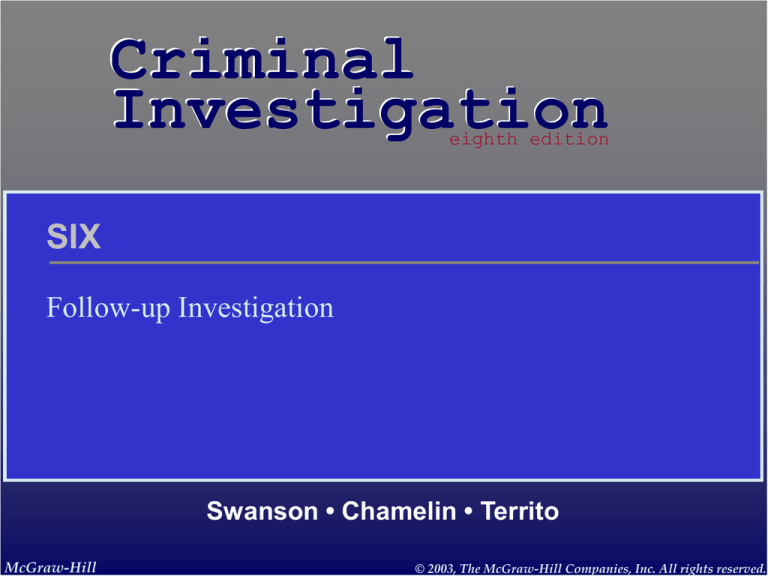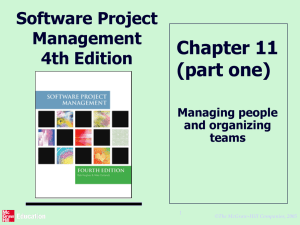
Criminal
Investigation
eighth edition
SIX
Follow-up Investigation
Swanson • Chamelin • Territo
McGraw-Hill
© 2003, The McGraw-Hill Companies, Inc. All rights reserved.
LEARNING OBJECTIVES
• Summarize the factors used to determine whether a
follow-up investigation is needed
• Outline common internal and external sources of case
information
• Explain the techniques used in neighborhood and
vehicle canvasses
• Discuss the role and use of informants
• Understand the purpose and objectives of surveillance
• Be familiar with the practice of polygraph and
psychological-stress evaluators
• Describe the methods for conducting photo and live
lineups
• Explain the guidelines for recording identification results
McGraw-Hill
6-1
© 2003, The McGraw-Hill Companies, Inc. All rights reserved.
INVESTIGATIVE SOLVABILITY FACTORS
• Can the identity of the suspect/s be established
through:
–
–
–
–
McGraw-Hill
Useable fingerprints being discovered
Significant physical evidence being located
Victims/witness/informant information
A license number of or a significant description of the
vehicle known to have been used in the offense
6-2(a) © 2003, The McGraw-Hill Companies, Inc. All rights reserved.
INVESTIGATIVE SOLVABILITY FACTORS
(cont'd)
• Is there serious physical harm or threat of
serious physical harm to the victim
– Did the suspect(s) utilize a deadly weapon or
dangerous ordinance
– Is there a significant m.o. which will aid in the solution
of the offense
– Is it a sex offense in which the victim and suspect(s)
had physical contact
McGraw-Hill
6-2(b) © 2003, The McGraw-Hill Companies, Inc. All rights reserved.
INVESTIGATIVE SOLVABILITY FACTORS
(cont'd)
–
–
–
–
McGraw-Hill
Can a suspect be named
Can a suspect be identified
Can a suspect be described
Is there another reason which leads you to believe
that the offense should be assigned for a follow-up
investigation
6-2(c) © 2003, The McGraw-Hill Companies, Inc. All rights reserved.
BURGLARY SCREENING DECISION MODEL
• One of the more
useful tools used by
investigators at the
onset of their effort is
a decision model form.
• This allows them to
objectively make
decisions with regard
to how best to
proceed with their
investigative work.
McGraw-Hill
6-3
© 2003, The McGraw-Hill Companies, Inc. All rights reserved.
COMMON INTERNAL SOURCES OF CASE INFORMATION
•
•
•
•
•
•
•
•
Incident and supplemental reports
Physical evidence seized
Jail booking reports
Field interview/information reports
Inventories of impounded vehicles
Traffic citations
Crime lab reports
The neighborhood and vehicle canvasses
McGraw-Hill
6-4
© 2003, The McGraw-Hill Companies, Inc. All rights reserved.
FIELD INTERVIEW/INFORMATION REPORTS
• A field
interview/information
card (FIR) is filled out
when patrolling
officers identify
persons or vehicles
that are suspicious to
them but are not
connected to any
particular offense.
(Source: Courtesy Springfield, Missouri, Police Department)
McGraw-Hill
6-5
© 2003, The McGraw-Hill Companies, Inc. All rights reserved.
NEIGHBORHOOD CANVASS
• A fundamental aspect of most investigations is
the neighborhood canvass
• The investigator contacts residents, merchants
and others in the immediate vicinity of the crime
• A systematic neighborhood canvass soon after
the crime may be useful in twenty percent of the
cases
• The extent of the canvass depends on:
– The type of offense
– The time of day
– The characteristics of the crime scene
McGraw-Hill
6-6
© 2003, The McGraw-Hill Companies, Inc. All rights reserved.
NEIGHBORHOOD CANVASS FORM
• This form provides the investigator with:
– A list of persons contacted
– Investigation notes for later analysis
– A source of potential leads
McGraw-Hill
6-7
(Source: Courtesy Imprimus
Forensic Services, LLC)
© 2003, The McGraw-Hill Companies, Inc. All rights reserved.
INFORMATION NEEDED BEFORE CONDUCTING A
NEIGHBORHOOD CANVASS
•
•
•
•
All information relating to the offense
A full description of the suspect
Any injury sustained by the suspect
The type of property taken
McGraw-Hill
6-8(a) © 2003, The McGraw-Hill Companies, Inc. All rights reserved.
INFORMATION NEEDED BEFORE CONDUCTING A
NEIGHBORHOOD CANVASS (cont'd)
• Possession of these facts is essential for:
– Officer’s safety
– For the intelligent questioning of possible witnesses
McGraw-Hill
6-8(b) © 2003, The McGraw-Hill Companies, Inc. All rights reserved.
INFORMANTS
• Information provided by informants often plays a
vital role in a successful investigation
• Such information may provide evidence of an
unreported crime
• Such information may provide the basis for a
search warrant
• Such information may constitute the basis for an
arrest
McGraw-Hill
6-9
© 2003, The McGraw-Hill Companies, Inc. All rights reserved.
MAJOR CATEGORIES OF INFORMANTS
• Mercenary informant - information provided for
financial reward
• Rival informant - information provided to
establish monopolistic control over activity in
question by eliminating a competitor
• Plea bargaining informant - information provided
to obtain reduced charges or lenient sentence
for information
• Self-aggrandizing informant - information
provided to obtain enhanced sense of selfimportance
McGraw-Hill
6-10(a)© 2003, The McGraw-Hill Companies, Inc. All rights reserved.
MAJOR CATEGORIES OF INFORMANTS
(cont'd)
• Fearful informant - information provided because
they are worried they will be endangered by the
criminal activities of an associate
• False informant - information provided is
misleading to direct the investigation away from
her/himself, friends, and relatives
• Anonymous informants - information provided by
an unknown person
• Legitimate informants - information provided by
a law abiding citizen out of a sense of civic duty
McGraw-Hill
6-10(b)© 2003, The McGraw-Hill Companies, Inc. All rights reserved.
EFFECTIVE USES OF SURVEILLANCE
• Establishing the existence of a violation
• Obtaining probable cause for a search warrant
• Apprehending violators in the commission of
illegal acts
• Identifying the violators’ associates
• Verifying informant reliability
McGraw-Hill
6-11(a)© 2003, The McGraw-Hill Companies, Inc. All rights reserved.
EFFECTIVE USES OF SURVEILLANCE
(cont'd)
• Providing protection for undercover investigators
or informants
• Locating persons, places, or things
• Preventing crime
• Gathering intelligence of individuals and
premises prior to the execution of a search
warrant
• Gathering intelligence on illegal groups' activities
McGraw-Hill
6-11(b)© 2003, The McGraw-Hill Companies, Inc. All rights reserved.
AREA UNDER VIDEO MONITORING
• The use of video
surveillance camera in
public places is
becoming common
• Such systems may deter
crime
• Video systems may also
gather evidence of a
crime
(Courtesy © Scott Iskowitz and Tampa Tribune)
McGraw-Hill
6-12
© 2003, The McGraw-Hill Companies, Inc. All rights reserved.
POLYGRAPH EXAMINATIONS
• These examinations are used to:
– verify, corroborate, or refute statements made by
victims, witnesses, and suspects
– obtain additional investigative leads
– narrow or focus the investigation
– eliminate suspects
McGraw-Hill
6-13
© 2003, The McGraw-Hill Companies, Inc. All rights reserved.
THE POLYGRAPH
• The polygraph is designed to record
physiological changes in:
– Respiratory rate
– Blood pressure and heart rate
– Amount of sweat on the fingertips
McGraw-Hill
6-14
© 2003, The McGraw-Hill Companies, Inc. All rights reserved.
POSED POLYGRAPH EXAM
• The polygraph is an
investigative tool
• It does not
substitute for a
proper investigation
• Only certified, well
trained
polygraphists
should be used
(Courtesy Lafayette Instrument)
McGraw-Hill
6-15
© 2003, The McGraw-Hill Companies, Inc. All rights reserved.
PSYCHOLOGICAL-STRESS EVALUATOR (PSE) AND
COMPUTERIZED VOICE-STRESS ANALYZER (CVSA)
• The PSE and the CVSA measures voice
fluctuations
• These fluctuations can indicate stress.
• They can also reveal deception
• Recordings of phone conversations can be used
in place of personal contact with a suspect
McGraw-Hill
6-16
© 2003, The McGraw-Hill Companies, Inc. All rights reserved.
PROCEDURES FOR PHOTO LINEUPS
• Include only one suspect in each identification
procedure
• Select “fillers” (nonsuspects) who generally
match the witness’ description of the perpetrator
• If multiple photos of the suspect are available,
use the one made closest to the time when the
crime was committed
• Lineups should include a minimum of five fillers
• If there are multiple witnesses, consider placing
the suspect in different positions each time a
lineup shows to a witness
McGraw-Hill
6-17(a)© 2003, The McGraw-Hill Companies, Inc. All rights reserved.
PROCEDURES FOR PHOTO LINEUPS
(cont'd)
• If a new suspect is developed, avoid using fillers
which have been used in a previous lineup for
the same witness
• Make sure that no writing or information about
the suspect's previous criminal history can be
seen by the witness
• Before the witness views the lineup, check again
to make sure the suspect doesn’t unduly
standout
• Record the presentation order or the lineup and
handle the original photographs as evidence
• Write a supplemental report which
chronologically describes what happened
McGraw-Hill
6-17(b)© 2003, The McGraw-Hill Companies, Inc. All rights reserved.
WITNESS LINEUP IDENTIFICATION FORM
• Investigators carefully document witness responses to a
live lineup by using this form
• Note the names of the witness, the officer, the prosecutor
and the defense attorney all appear on the form
(Source: Courtesy St. Petersburg, Florida, Police Department)
McGraw-Hill
6-18
© 2003, The McGraw-Hill Companies, Inc. All rights reserved.
RECORDING IDENTIFICATION RESULTS
• Proper documentation includes:
– check to make sure that all signatures need for the
various forms are completed;
– collect the information needed to complete standard
forms prior to conducting the lineup procedure;
– if another witness will have contact with any
photographs or forms, make sure that the previous
witness has not made any marks or comments on
them; and
– include in the supplemental report a record of both
identification and non-identification results, including
any statements as to how sure, or unsure, the
witness is
McGraw-Hill
6-19
© 2003, The McGraw-Hill Companies, Inc. All rights reserved.
AUTOMATED PHOTO LINE UP
• Today investigators may use automated photo-line up
programs
• Witness descriptions are entered into the computer
• The computer searches the database of suspects and
persons with similar physical characteristics
(Courtesy of TFP, Inc.)
McGraw-Hill
6-20
© 2003, The McGraw-Hill Companies, Inc. All rights reserved.








